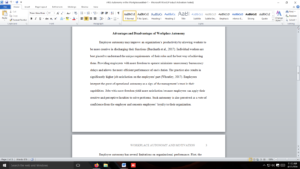Autonomy and micromanagement.
Management should be more about enabling employees to be successful than overseeing their every move. This is especially true in early childhood programs where the teachers may function autonomously in some respects but are beholden to the established procedures of the larger organization. When more direct supervision is warranted, managers must attempt to strike a balance that falls somewhere between complete autonomy and micromanagement.
Consider both the positive and negative aspects of autonomy in the workplace. What might a manager need to do to be sure employees are fulfilling their obligations while maintaining a comfortable level of autonomy?
Submit a 2- to 3-page response that includes the following:
- What are the risks and benefits of allowing team members to be autonomous? When is autonomy appropriate, and when is it appropriate to adhere to established protocols?
- What procedures would need to be put in place to ensure that assignments are still being completed?
- What happens when your employees are educated in a Type X environment? As a manager, how can you help them succeed in a Type I environment? Be specific.
Answer preview
Employee autonomy is appropriate for employers who have garnered sufficient expertise or experience in a specified field that they can be trusted to exercise proper judgment (Baird et al., 2018). The approach also suffices for the allocation of roles within teams where the top management has already determined the contribution expected from each group. In such instances, micromanagement is unnecessary because the team members know their strengths and allocate people’s roles. However, clear protocols should be established in circumstances where the persons discharging certain functions have limited experience (Baird et al., 2018). Similarly, the organization should establish clear guidelines for sensitive tasks concerning people’s safety and consumers’ concerns.
[876 Words]

Autonomy and micromanagement.

